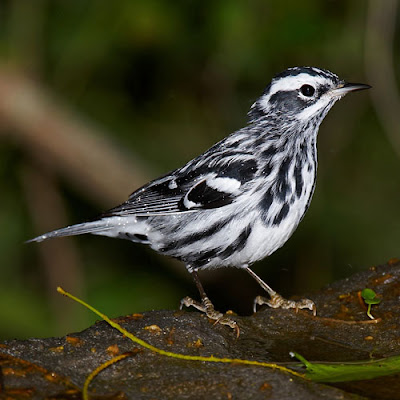
I think we had a successful birding weekend as we were able to add some a new bird to our life lists- the blue-headed vireo! Unfortunately, we were not able to get a picture as these guys move very quickly through the tops of the trees. We were able to use the binoculars to make an ID, but that was it. We used the colour, the movement and the white eye ring to help us identify it. Here's what I've learned about the blue-headed vireo from whatbird.com:
- The Blue-headed Vireo, the Plumbeous Vireo, and Cassin's Vireo were formerly considered a single species known as the Solitary Vireo. In 1997, the Blue-headed Vireo reappeared as a distinct species when molecular genetic studies demonstrated differences among the Solitary Vireo complex.
- Because the deciduous trees have not leafed out when the vireos arrive on their breeding grounds, most courtship nests and first breeding nests are built in evergreen hemlock trees.
- Their dependence upon hemlocks may prove troublesome because this tree is being decimated by an introduced Asian insect, the hemlock wooly adelgid.
- A group of vireos are collectively known as a "call" of vireos.
Blue-headeds have a sweet song; high, clear phrases with sweet notes: see you, cheerio, be-seein-u, so-long, seeya.
So lovely!
Here is a picture I found online:

We also saw the black and white warbler, which was our first sighting of this bird in 2009. We thought we saw a yellow(ish) warbler, but since these birds don't stay in one place for long, it was impossible to be sure. Here's an online pic from http://nationalzoo.si.edu

Other birds we saw include brown creeprs, crows, the white-breasted nuthatch, hairy and downy woodpeckers, chickadees, robins, crows, and bluejays.
Rare sightings for us included:
-the yellow-bellied sapsucker (there were plenty of those around, making very loud squeaking noises). You can see the pattern on the tree from where the sapsucker has made holes.



-the eastern wood pewee (we heard this bird quite a bit, but didn't see any at all)
-the pileated woodpecker came down by our site and worked her way along trees, which allowed us to watch her for quite some time.



-the red-tailed hawk that decided to fly directly through our site, then perched in a tree just across from us for probably close to an hour. This gave us one of our longest and most close-up views for an adult red-tailed ever. He/She went after one of the sapsuckers, but the sapsucker got away.


-the great blue heron that flew overhead and made lots of noise (again, too fast and too far for a picture)
-Common loons spotted across Kettle Lake.
-American redstarts- one adult male and a female or juvenile as well.
We woke up the first night at some point to three loud, distinct "hoots". We knew it was an owl, but we weren't sure which one until we looked up the calls online and we are fairly certain it was the call of a long-eared owl. Another first!
On our last morning (Monday) we heard the distinct call of the Barred Owl (twice), echoing throughout the site. That was the first time we've heard this in the wild.
This is the only physical evidence of owls we saw:

We also identified a gull as the ring-billed gull. We haven't paid much attention to gulls before now, but we're thinking we'll start adding them to our lists as well. The gulls are similar to sparrows in that there are so many of them with just some variation between each that it can be overwhelming to new birders (or at least to us!).

Overall, a great long weekend with lots of fun and lots of birding!







No comments:
Post a Comment